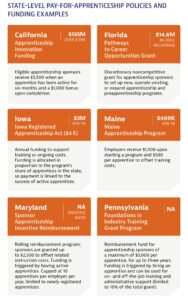Key Highlights
Challenges
The United States offers far fewer apprenticeship opportunities than other countries. Existing public funding for apprenticeships in the U.S. is small and patchwork, involving federal, state, public, private, and some philanthropic funds. Businesses have generally been willing to pay wages to apprentices, but less willing to take on the other administrative functions required to establish and maintain an apprenticeship program, such as recruiting, recordkeeping, and coordination of apprentices’ technical instruction. Intermediary organizations are needed to persuade employers to try apprenticeships and then help employers establish programs and comply with funding requirements.
Opportunities
Apprenticeship pay-for-success programs are publicly funded with multi-year commitments that pay a fixed rate per apprentice. To be compensated with public funding, the apprenticeship program must meet one or more success milestones, such as hiring, retention, or wage increases.
Successful apprenticeship programs benefit businesses by developing productive employees and apprentices by providing a pathway to a career in a high-paying occupation. Public pay-for-success funding models lead to rapid growth in successful apprenticeship programs — as evidenced by examples from England, France, and Australia and some states — and would provide significant benefits to businesses, workers, and the U.S. economy. The return on investment for such programs would be around $1.68 for every dollar invested.

Next Steps
- Policymakers can create federal funding opportunities for apprenticeships that use a pay-for-success model
- Scaling apprenticeships will require mobilizing an army of intermediary organizations with the expertise needed to create successful apprenticeship programs for businesses




